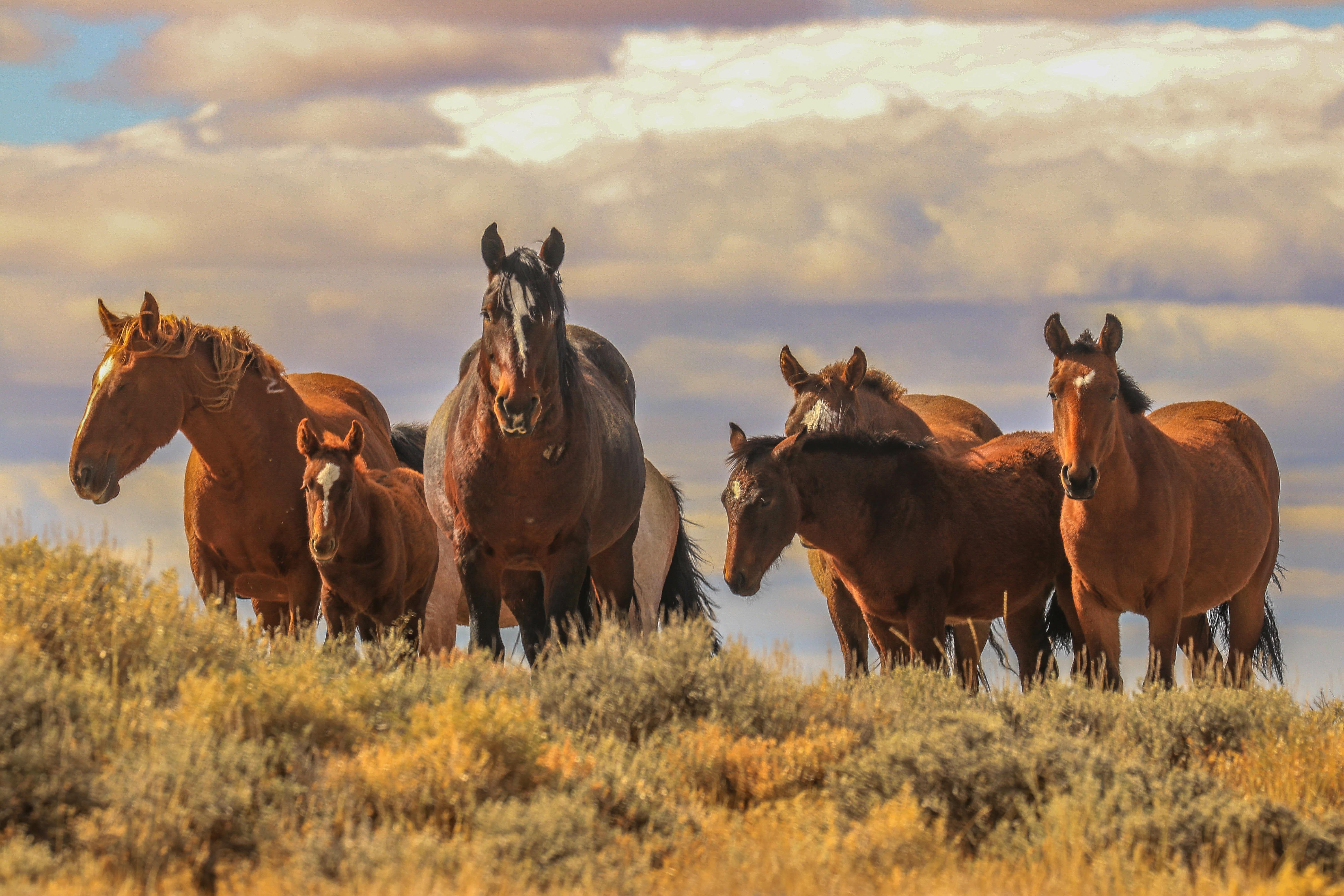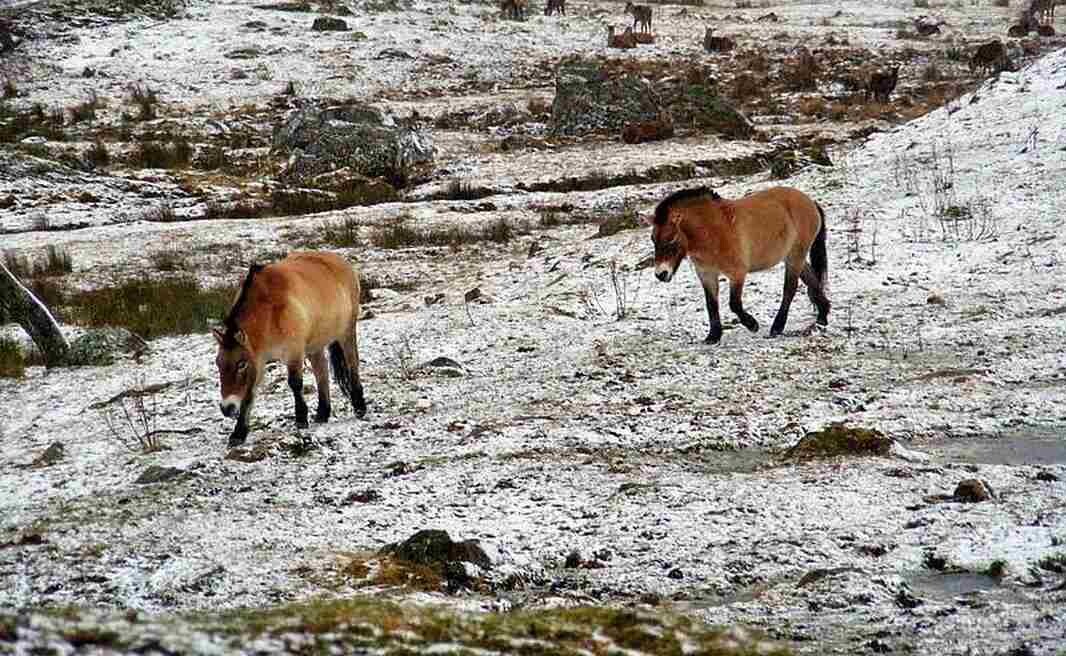When picturing the Wild West, images of cowboys, swirling lassos, and thundering wild mustangs likely come to your mind. These magnificent creatures still run across North American landscapes today.
Descended from horses brought by early European settlers, over 60,000 free-roaming mustangs now live in the western territories made iconic by their ancestors. Their name originates from the word ‘mestengo,’ which is Spanish for ‘wild’ and ‘stray.’
Mustangs share the lands with fellow wildlife, impacting plant life, vying over resources, and capturing imaginations as enduring symbols of American culture. Peek into their world to uncover what empowers their survival and behold their intricate social bonds.
Mustang ways and whinnies
From a flick of the tail to a piercing squeal, an American mustang talks through its body. Pinned back ears signal trouble ahead, while pricked ears show they’re tuned in. Mustangs vocalize, too—from foal-guiding nickers to far-carrying cries announcing danger. Bands even relay through scent marks, using their noses to identify other members.
Like other wild animals, mustangs can spot threats from miles away thanks to far-seeing eyes. With vision spanning ahead and behind, they can constantly scan for danger. Their keen hearing and scent also help the vigilant creatures sniff out essentials like food and water while tracking their herd.
Clever and curious, mustangs live in bands where elders teach the next generation. Foals glean survival lessons from seniors about ideal plants to eat or how to respond when threats arise. When met with new obstacles like dwindling grazing or blocked trails, these creatures rely on accumulated wisdom passed down from generation to generation.
The order of the horse
- Herd dynamics: complex relationships
Mustang bands tend to run in two structures: harems and bachelor groups.
Harems follow a lead stallion, a small herd of mares, and all their foals. Stallions announce their dominance with shows of grit while mares teach the young their ways and lead the band to viable grazing. Between family bands range bachelor mustangs—adolescents biding time before starting their own harem by wooing mares from afar.
From corrective nips at wandering foals to subtle signals smoothing disagreements, communication holds bands together. Stallions reinforce respect through posturing plays, while mutual grooming sessions bond friend to friend. Through these customs forged over the years, coherence and community thrive.
- Cooperation and competition: allies and rivals
Though bachelor bands run as brothers, ambition also brews in each horse, longing to one day start his own harem. While bonding in the band, individuals eye chances to better their odds as suitable studs. But cooperation holds the key. Even rivals nicker greetings and graze together when needs arise. For out in the wild, lone mustangs don’t survive the lean times.
In rearing up foals, mares share the duty as a sisterhood. Mustangs are among mammals like humans and striped hyenas that practice alloparenting or communal parenting. In raising the future generation, mares work together to care for all foals, even those of others within the band. With few predators, mustang bands may also double in size every four to five years.
True grit and wild ingenuity
- Daily rhythms and routines: patterns of necessity
Like many wild herbivores, mustangs follow natural patterns under daylight to avoid the threat of potential predators. Mornings mean grazing, while afternoons allow resting, sometimes while standing up. Meanwhile, bachelor bands may journey farther between meals.
When the land becomes harsh, mustang bands draw inward to weather the trial, conserving strength yet keeping ceaseless watch against threats. Forged by wilderness, the horses adapt naturally to the demands of their changing home.
- Survival strategies: adaptability and endurance
As scarce resources drive them onward, mustang bands may wander 15 relentless miles or more in a single day. Hard hooves make the trek while keen senses sniff out grazing. Their path follows old migration routes mapped deep in memory and retraced through generations. Past survival strengthens them for whatever the prairie brings next. Onward they go, the living inheritance of ancestors who painted freedom across the backlands.
- Mustangs: wild wonder or neighing nuisance
Some people might see mustangs as a nuisance due to their hardiness and growing populations. Managing swelling numbers brings complicated challenges. While initiatives like adoption and roundups curb numbers, their methods remain controversial. Still, certain areas necessitate oversight of band sizes based on local environmental impact.

An enduring symbol of the American West
In those wild bands racing the windblown plains, witness unyielding bonds instead of only icons. See lead mares guiding their kin to secluded water. Watch elders sharing wisdom that shields the youth. Observe bachelors band together until their day arrives to lead. Know these horses draw life from the community—the stalwart solidarity that shepherds them through every storm.
Call it grit or call it spirit, but know this: no hardship can claim the mustang bands who sculpted the frontier. Liberty and wisdom ride double in their saddlebags across generations. They run today undaunted as their forebears did yesterday, surviving their way across the plains.



Leave a Reply